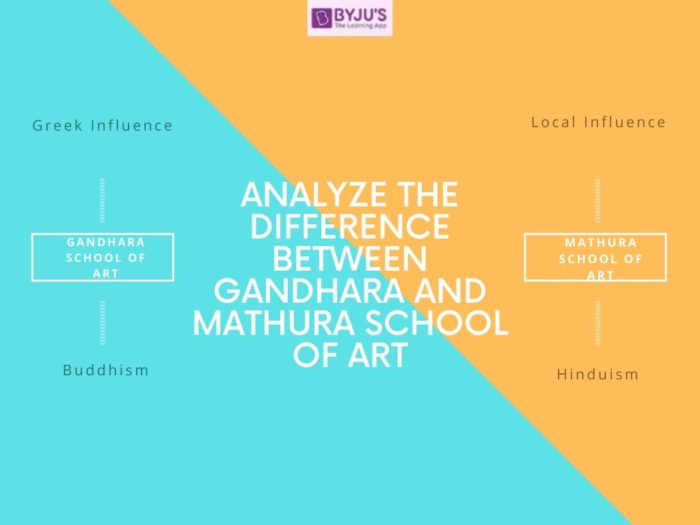India has a rich and varied culture as characterized in the later art forms of the subcontinent, dating from the 14th through the 19th century. Art and culture is an important topic in the IAS Exam. A substantial number of questions can be asked from the art and culture segment in UPSC Prelims as well as Mains examination. Here we are giving the major difference between the Gandhara School of Art and the Mathura school of Art.
The Gandhara School of Art
During the Kushana Empire’s rule, the Gandhara art prospered in India. Above all, Kanishka, the greatest of the Kushanas was a famous backer of art and architecture. The Gandhara School of art flourished in his reign. Gandhara School was profoundly influenced by Greek methodologies.
The figures of Buddha were more spiritual and carved mainly in grey and bluish-grey colour with the finest details.
The Mathura School of Art
The Mathura School of Art was entirely influenced by Indianism. The stone used in the Mathura school of arts was red sandstone. The sculptures were less spiritual.
They mostly used the spotted red sandstone for making sculptures and statues. The initial images of the Buddha and the Bodhisattva are happy and fleshy figures with little spirituality about them. The Mathura School of arts prided themselves on creating images of Buddha and they also made statues of many gods and goddesses such as Jain Tirthankaras.
To know more in detail about the Buddha and his Teachings, visit the linked article

Difference between Mathura and Gandhara School of Art
Although both the Mathura and Gandhara schools of Art share some rudimentary similarities between themselves, there are some fundamental differences between the two: which is highlighted in the table given below:
| Areas of differences | Gandhara School of art | Mathura School of Art |
| Reign | Kushana Dynasty | Kushana Dynasty |
| Area | Gandhara (Now located in the Peshawar Valley of Modern-day Pakistan) | Mathura |
| Outside influences | Greek and possibly Macedonian influence |
|
| Religious influence | Buddhism |
|
| Material Used | Bluish- Grey sandstone
Grey sandstone |
Spotted red sandstone |
| Features of Buddha sculptures | Spiritual Buddha
Sad Buddha Bearded Buddha Less ornamentation Great detailing Buddha in Yogi postures Greek factors like wavy hair, large forehead, long ears |
Smiling Buddha
Less emphasis on spiritual aspects Shaven head and face Muscular Physique Graceful posture of Buddha Seated in Padmasana Buddha surrounded by two monks: Padmapani (holding Lotus) and Vajrapani( Holding Vajra) Halo around the head of Buddha decorated with geometrical motifs The Standing Buddhas of the Sravasti, Sarnath, and Kausambhi
|
| Various Mudras of Buddha in Gandhara Art | Abhayamudra- Don’t fear
Bhumisparshamudra -Touching the earth Dhyana mudra- Meditation Dharmachakramudra- A preaching mudra |
— |
Thus learning about the various schools of art is essential as this is an important topic that can be asked in the IAS exam. You can also refer to the following links to prepare for the Art and Culture segment of the exam.
- NCERT Notes for Art and Culture for UPSC
- How to Tackle UPSC Art and Culture
- Difference Between Art and Culture
Aspirants can find more Difference Between Articles, by visiting the linked page
Gandhara and Mathura School of Art (UPSC Notes):- Download PDF Here
Frequently Asked Questions about Gandhara and Mathura School of Art
Who founded Gandhara school of art?
What is Mathura school of art?
Candidates can find the general pattern of the UPSC Exams by visiting the UPSC Syllabus page. For more articles and exam-related preparation materials, refer to the links given in the table below:
Related Links
Comments